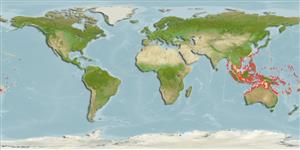Environment: milieu / climate zone / depth range / distribution range
Ecology
Marine; reef-associated; depth range 1 - 40 m (Ref. 1602). Tropical; 30°N - 25°S, 92°E - 160°W
Western Pacific: fringe of the eastern sector of the Indian Ocean, Cocos (Keeling) Islands, Australia, Indonesia, Singapore, Gulf of Thailand, South China Sea, Philippines, Taiwan, Ryukyu Islands, Ogasawara Islands, Mariana Islands, Palau (Belau), Caroline Islands, Kapingamarangi Islands, Nauru and Niue. The species is replaced by its sibling, Siganus stellatus, in the Andaman Sea and regions which are located further west.
Length at first maturity / Size / Weight / Age
Maturity: Lm ?, range 24 - ? cm
Max length : 40.0 cm TL male/unsexed; (Ref. 9710); common length : 30.0 cm TL male/unsexed; (Ref. 9813)
Dorsal spines (total): 13; Dorsal soft rays (total): 10; Anal spines: 7; Anal soft rays: 9; Vertebrae: 13. Color pattern changes with age; iris silver with 8-10 orange spots. Juveniles with a deep brown patch straddling the lateral line; the spot becoming obscured with increase in size. Stout, venomous spines not so pungent. Preopercular angle 87°-105°. Strong scales fully cover the cheeks. Midline of thorax scaled but not pelvic ridges.
Occurs in clear lagoons and seaward reefs. Juveniles live in schools of up to about 50 fish with pairing commencing as small as 15 cm, but fish may still be schooling at 22 cm SL; older fish live in pairs. Feeds on benthic algae (Ref. 9813). Adults on deep coastal reefs, juveniles in shallow estuaries (Ref. 48637).
Life cycle and mating behavior
Maturity | Reproduction | Spawning | Eggs | Fecundity | Larvae
Spawn in pairs. Spawning occurs around either new or full moons or both (Ref. 37816).
Woodland, D.J., 1990. Revision of the fish family Siganidae with descriptions of two new species and comments on distribution and biology. Indo-Pac. Fish. (19):136 p. (Ref. 1419)
IUCN Red List Status (Ref. 130435: Version 2024-1)
Human uses
Fisheries: commercial
Tools
Special reports
Download XML
Internet sources
Estimates based on models
Preferred temperature (Ref.
123201): 24.7 - 29, mean 28 °C (based on 662 cells).
Phylogenetic diversity index (Ref.
82804): PD
50 = 0.5000 [Uniqueness, from 0.5 = low to 2.0 = high].
Bayesian length-weight: a=0.01288 (0.00829 - 0.02001), b=3.15 (3.02 - 3.28), in cm total length, based on LWR estimates for this species & Genus-body shape (Ref.
93245).
Trophic level (Ref.
69278): 2.0 ±0.00 se; based on food items.
Resilience (Ref.
120179): High, minimum population doubling time less than 15 months (Preliminary K or Fecundity.).
Fishing Vulnerability (Ref.
59153): Low to moderate vulnerability (30 of 100).
Nutrients (Ref.
124155): Calcium = 32.8 [15.9, 75.0] mg/100g; Iron = 0.648 [0.309, 1.495] mg/100g; Protein = 18.5 [17.0, 20.0] %; Omega3 = 0.101 [0.051, 0.202] g/100g; Selenium = 24.1 [9.7, 61.1] μg/100g; VitaminA = 28.4 [6.6, 118.1] μg/100g; Zinc = 1.27 [0.50, 2.68] mg/100g (wet weight);
